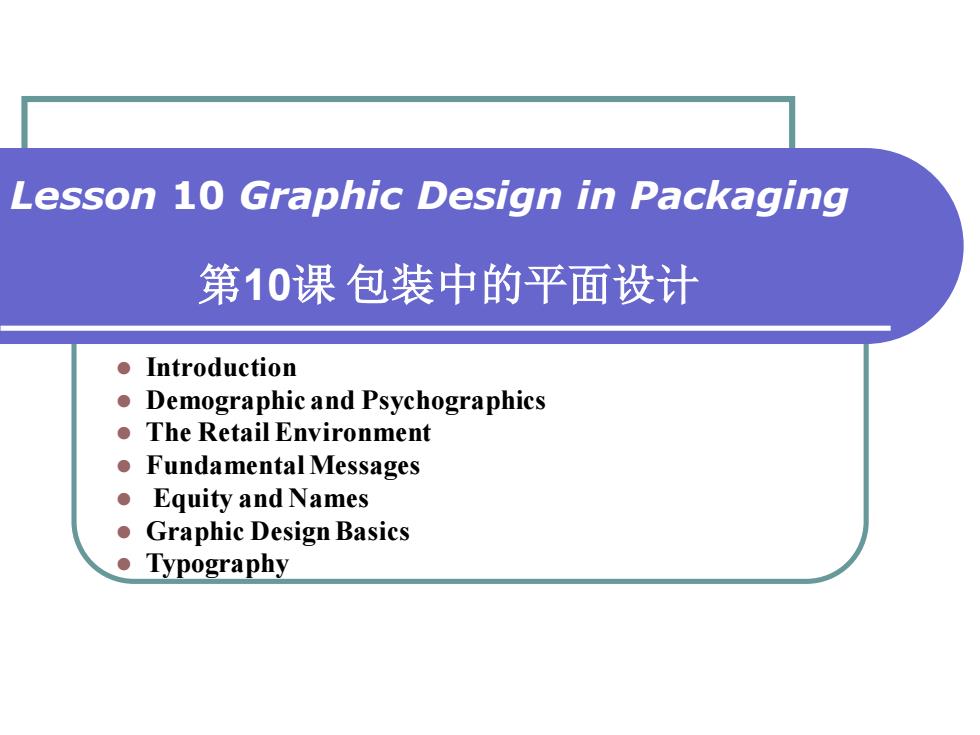
Lesson 10 Graphic Design in Packaging 第10课 包装中的平面设计 ⚫ Introduction ⚫ Demographic and Psychographics ⚫ The Retail Environment ⚫ Fundamental Messages ⚫ Equity and Names ⚫ Graphic Design Basics ⚫ Typography
Lesson 10 Graphic Design in Packaging 第10课 包装中的平面设计 ⚫ Introduction ⚫ Demographic and Psychographics ⚫ The Retail Environment ⚫ Fundamental Messages ⚫ Equity and Names ⚫ Graphic Design Basics ⚫ Typography

一、 Introduction A package design is composed of two separate components: 1. Features and characteristics Containment, protection/preservation, qualities 2. Attract consumer and motivate purchase decision surface decoration, form, material, shape ⚫ Overview of the information ⚫ Create packages to observer. ⚫ Attention to product Consideration of the package design Sophisticated graphics and misleading statements
一、 Introduction A package design is composed of two separate components: 1. Features and characteristics Containment, protection/preservation, qualities 2. Attract consumer and motivate purchase decision surface decoration, form, material, shape ⚫ Overview of the information ⚫ Create packages to observer. ⚫ Attention to product Consideration of the package design Sophisticated graphics and misleading statements
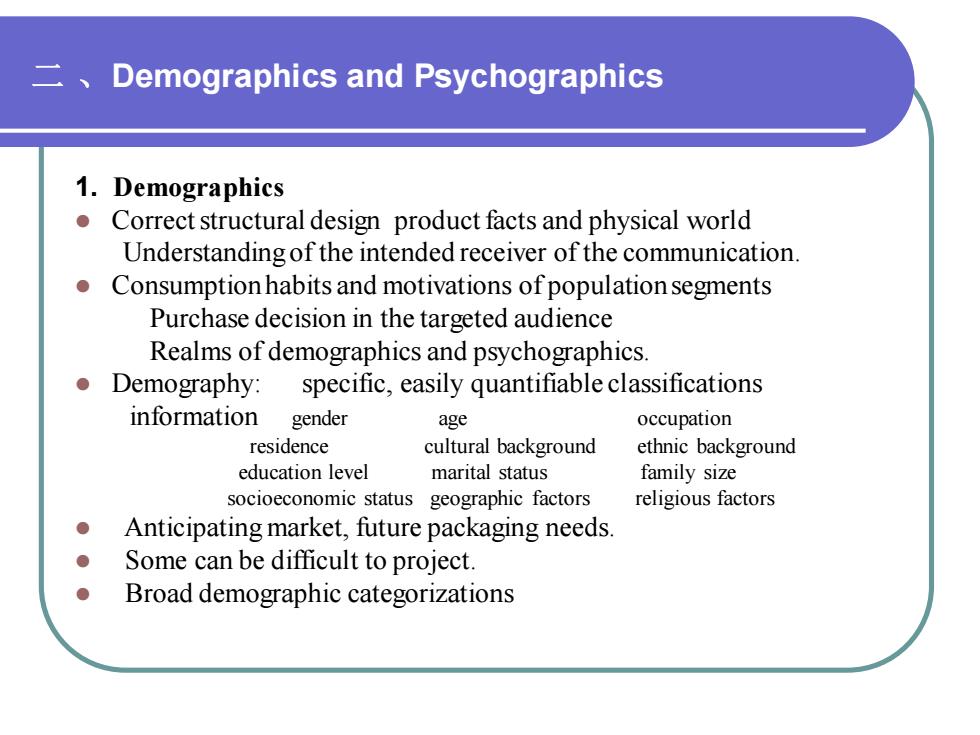
二 、Demographics and Psychographics 1. Demographics ⚫ Correct structural design product facts and physical world Understanding of the intended receiver of the communication. ⚫ Consumption habits and motivations of population segments Purchase decision in the targeted audience Realms of demographics and psychographics. ⚫ Demography: specific, easily quantifiable classifications information gender age occupation residence cultural background ethnic background education level marital status family size socioeconomic status geographic factors religious factors ⚫ Anticipating market, future packaging needs. ⚫ Some can be difficult to project. ⚫ Broad demographic categorizations
二 、Demographics and Psychographics 1. Demographics ⚫ Correct structural design product facts and physical world Understanding of the intended receiver of the communication. ⚫ Consumption habits and motivations of population segments Purchase decision in the targeted audience Realms of demographics and psychographics. ⚫ Demography: specific, easily quantifiable classifications information gender age occupation residence cultural background ethnic background education level marital status family size socioeconomic status geographic factors religious factors ⚫ Anticipating market, future packaging needs. ⚫ Some can be difficult to project. ⚫ Broad demographic categorizations
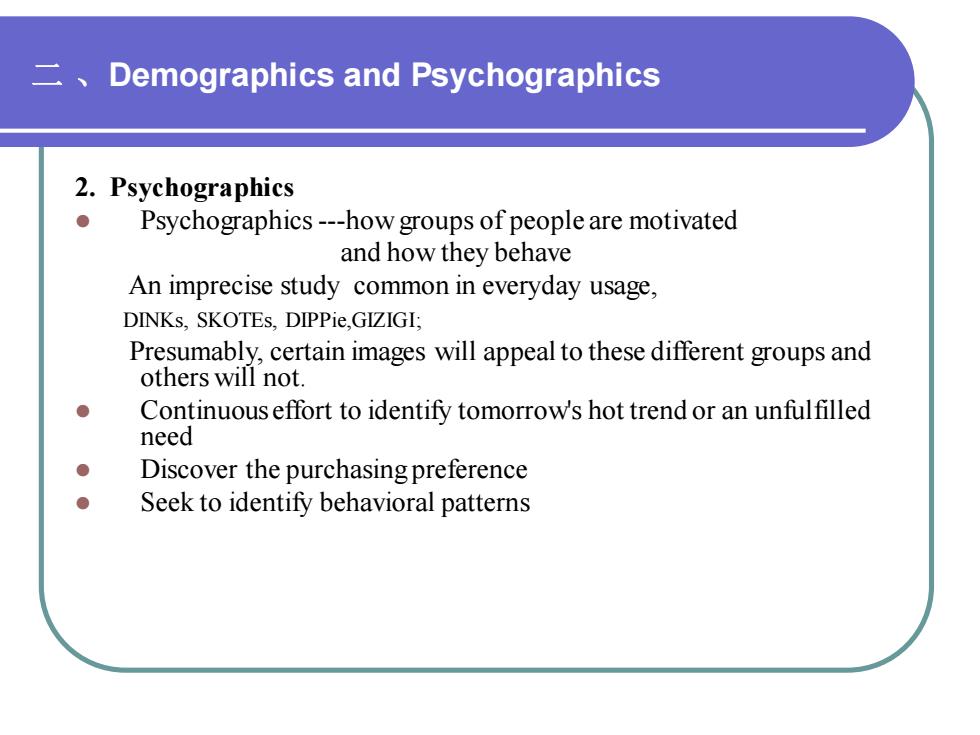
二 、Demographics and Psychographics 2. Psychographics ⚫ Psychographics -how groups of people are motivated and how they behave An imprecise study common in everyday usage, DINKs, SKOTEs, DIPPie,GIZIGI; Presumably, certain images will appeal to these different groups and others will not. ⚫ Continuous effort to identify tomorrow's hot trend or an unfulfilled need ⚫ Discover the purchasing preference ⚫ Seek to identify behavioral patterns
二 、Demographics and Psychographics 2. Psychographics ⚫ Psychographics -how groups of people are motivated and how they behave An imprecise study common in everyday usage, DINKs, SKOTEs, DIPPie,GIZIGI; Presumably, certain images will appeal to these different groups and others will not. ⚫ Continuous effort to identify tomorrow's hot trend or an unfulfilled need ⚫ Discover the purchasing preference ⚫ Seek to identify behavioral patterns
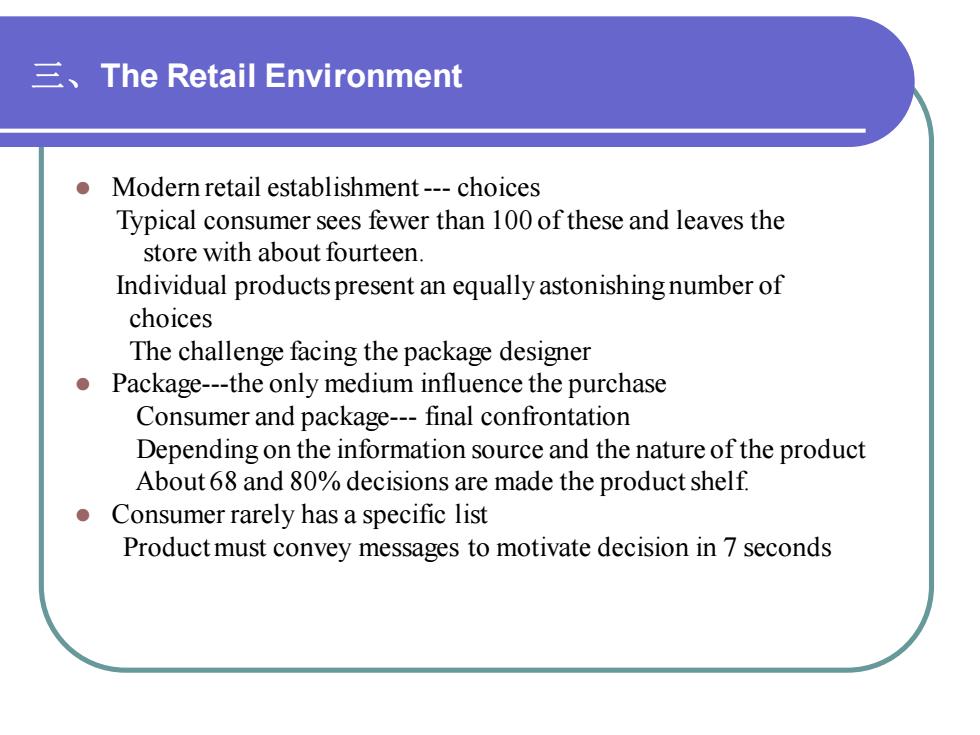
三、The Retail Environment ⚫ Modern retail establishment - choices Typical consumer sees fewer than 100 of these and leaves the store with about fourteen. Individual products present an equally astonishing number of choices The challenge facing the package designer ⚫ Package-the only medium influence the purchase Consumer and package- final confrontation Depending on the information source and the nature of the product About 68 and 80% decisions are made the product shelf. ⚫ Consumer rarely has a specific list Product must convey messages to motivate decision in 7 seconds
三、The Retail Environment ⚫ Modern retail establishment - choices Typical consumer sees fewer than 100 of these and leaves the store with about fourteen. Individual products present an equally astonishing number of choices The challenge facing the package designer ⚫ Package-the only medium influence the purchase Consumer and package- final confrontation Depending on the information source and the nature of the product About 68 and 80% decisions are made the product shelf. ⚫ Consumer rarely has a specific list Product must convey messages to motivate decision in 7 seconds
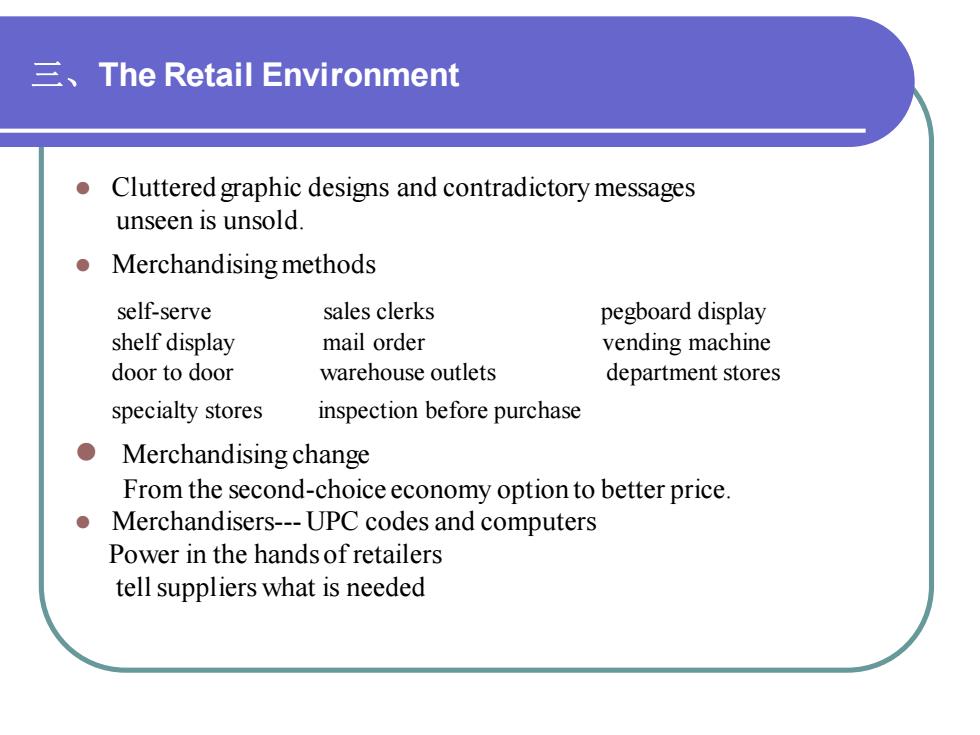
三、The Retail Environment ⚫ Cluttered graphic designs and contradictory messages unseen is unsold. ⚫ Merchandising methods self-serve sales clerks pegboard display shelf display mail order vending machine door to door warehouse outlets department stores specialty stores inspection before purchase ⚫ Merchandising change From the second-choice economy option to better price. ⚫ Merchandisers- UPC codes and computers Power in the hands of retailers tell suppliers what is needed
三、The Retail Environment ⚫ Cluttered graphic designs and contradictory messages unseen is unsold. ⚫ Merchandising methods self-serve sales clerks pegboard display shelf display mail order vending machine door to door warehouse outlets department stores specialty stores inspection before purchase ⚫ Merchandising change From the second-choice economy option to better price. ⚫ Merchandisers- UPC codes and computers Power in the hands of retailers tell suppliers what is needed
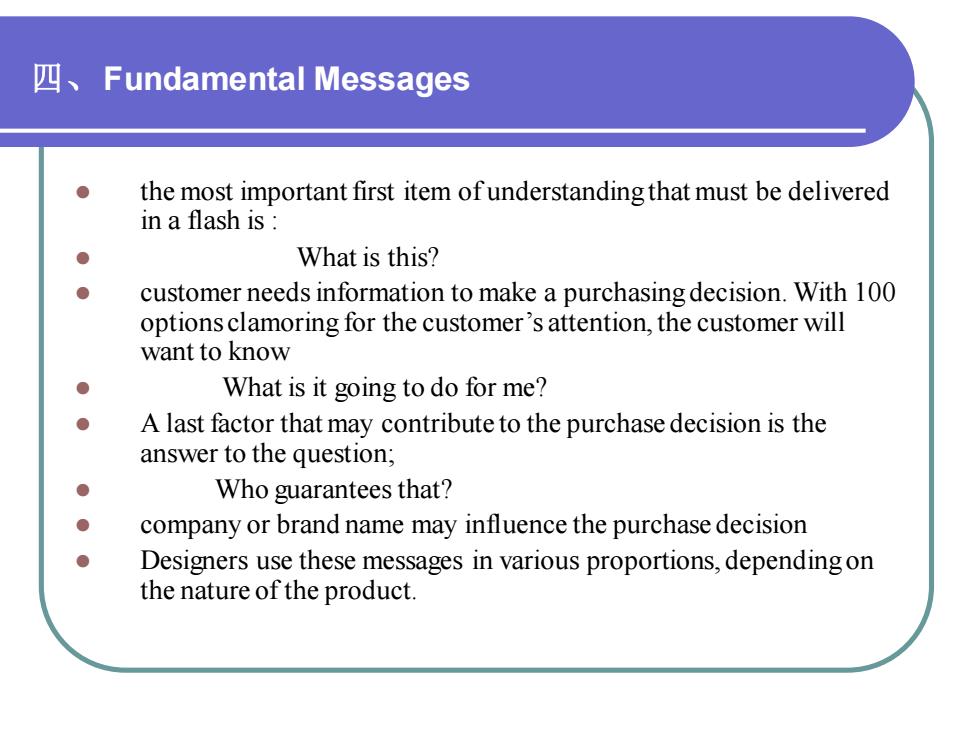
四、Fundamental Messages ⚫ the most important first item of understanding that must be delivered in a flash is : ⚫ What is this? ⚫ customer needs information to make a purchasing decision. With 100 options clamoring for the customer’s attention, the customer will want to know ⚫ What is it going to do for me? ⚫ A last factor that may contribute to the purchase decision is the answer to the question; ⚫ Who guarantees that? ⚫ company or brand name may influence the purchase decision ⚫ Designers use these messages in various proportions, depending on the nature of the product
四、Fundamental Messages ⚫ the most important first item of understanding that must be delivered in a flash is : ⚫ What is this? ⚫ customer needs information to make a purchasing decision. With 100 options clamoring for the customer’s attention, the customer will want to know ⚫ What is it going to do for me? ⚫ A last factor that may contribute to the purchase decision is the answer to the question; ⚫ Who guarantees that? ⚫ company or brand name may influence the purchase decision ⚫ Designers use these messages in various proportions, depending on the nature of the product

四、Fundamental Messages ⚫ 1. What is this? (the chords of familiarity) - instantly recognize ⚫ Direct common names are the most familiar ⚫ Appropriate with new products.) ⚫ Brand names become synonymous with the product ⚫ 2. The second message ⚫ What is it going to do for me? (the point of difference). recognize the benefit or virtue of the product. In a choice of 12 different kinds of rice, the chord of familiarity is "rice." The points of difference that characterize them might be ⚫ instant rice long-grain rice ⚫ wild rice Cajun-style rice ⚫ rice and tomato free recipe book with this rice ⚫ win a trip to Florida rice famous person eats this rice
四、Fundamental Messages ⚫ 1. What is this? (the chords of familiarity) - instantly recognize ⚫ Direct common names are the most familiar ⚫ Appropriate with new products.) ⚫ Brand names become synonymous with the product ⚫ 2. The second message ⚫ What is it going to do for me? (the point of difference). recognize the benefit or virtue of the product. In a choice of 12 different kinds of rice, the chord of familiarity is "rice." The points of difference that characterize them might be ⚫ instant rice long-grain rice ⚫ wild rice Cajun-style rice ⚫ rice and tomato free recipe book with this rice ⚫ win a trip to Florida rice famous person eats this rice

五、Equity and Brand Names 1. Equity ⚫ products have graphic elements or icons easily identified Company name, brand name, symbol, typographic style, color or color pattern, or any combination of these. Kellogg's; Coca-Cola's bottle shape and can color pattern; Campbell's Soup's red-and-white can label, the Heinz "tombstone" logo; McDonald's golden arches Equity is built by establishing a reputation for consistently good product and service over a long time period. Icons are highly recognizable symbols that have major motivational impacts on a consumer's purchasing decision. Icons with high equity are always carried on new product lines in order to immediately establish the heritage and trust
五、Equity and Brand Names 1. Equity ⚫ products have graphic elements or icons easily identified Company name, brand name, symbol, typographic style, color or color pattern, or any combination of these. Kellogg's; Coca-Cola's bottle shape and can color pattern; Campbell's Soup's red-and-white can label, the Heinz "tombstone" logo; McDonald's golden arches Equity is built by establishing a reputation for consistently good product and service over a long time period. Icons are highly recognizable symbols that have major motivational impacts on a consumer's purchasing decision. Icons with high equity are always carried on new product lines in order to immediately establish the heritage and trust
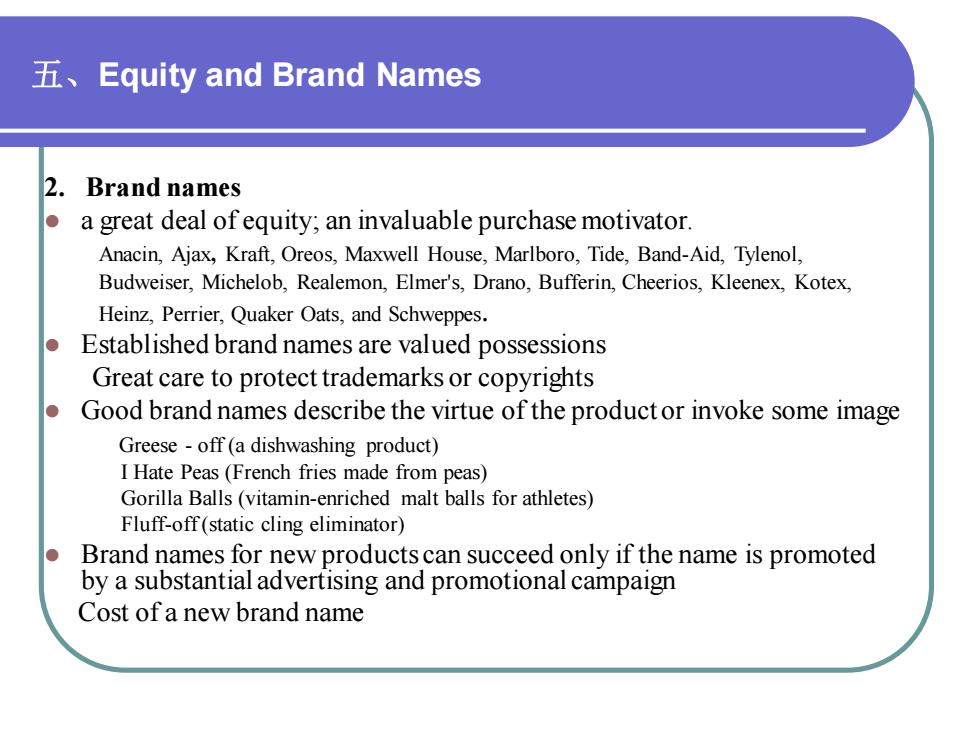
五、Equity and Brand Names 2. Brand names ⚫ a great deal of equity; an invaluable purchase motivator. Anacin, Ajax, Kraft, Oreos, Maxwell House, Marlboro, Tide, Band-Aid, Tylenol, Budweiser, Michelob, Realemon, Elmer's, Drano, Bufferin, Cheerios, Kleenex, Kotex, Heinz, Perrier, Quaker Oats, and Schweppes. ⚫ Established brand names are valued possessions Great care to protect trademarks or copyrights ⚫ Good brand names describe the virtue of the product or invoke some image Greese - off (a dishwashing product) I Hate Peas (French fries made from peas) Gorilla Balls (vitamin-enriched malt balls for athletes) Fluff-off (static cling eliminator) ⚫ Brand names for new products can succeed only if the name is promoted by a substantial advertising and promotional campaign Cost of a new brand name
五、Equity and Brand Names 2. Brand names ⚫ a great deal of equity; an invaluable purchase motivator. Anacin, Ajax, Kraft, Oreos, Maxwell House, Marlboro, Tide, Band-Aid, Tylenol, Budweiser, Michelob, Realemon, Elmer's, Drano, Bufferin, Cheerios, Kleenex, Kotex, Heinz, Perrier, Quaker Oats, and Schweppes. ⚫ Established brand names are valued possessions Great care to protect trademarks or copyrights ⚫ Good brand names describe the virtue of the product or invoke some image Greese - off (a dishwashing product) I Hate Peas (French fries made from peas) Gorilla Balls (vitamin-enriched malt balls for athletes) Fluff-off (static cling eliminator) ⚫ Brand names for new products can succeed only if the name is promoted by a substantial advertising and promotional campaign Cost of a new brand name